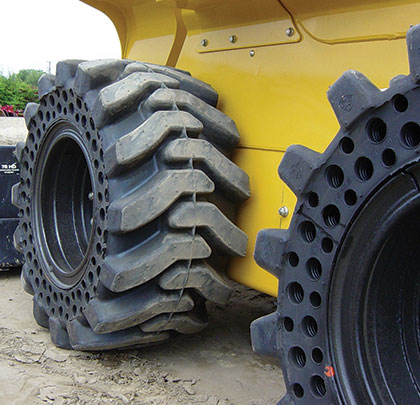Some manufacturers have conducted tests to further prove the benefit of semi-pneumatic tires. One demonstration involved cutting a 4-inch chunk out of a semi-pneumatic tire and observing the effects. The results showed the tire was still completely functional and able to keep working, something the other tires would not be able to do. And the semi-pneumatic tire isn’t just built to be virtually indestructible, it is also designed to provide a comfortable ride.
CUSHIONED COMFORT
Every operator has different definitions for what a comfortable ride entails. While it may not be a top priority to some, and others may not care at all, one way or the other, a bumpy ride will eventually take its toll on the driver after a period of time.
The all-rubber construction of a solid tire doesn’t allow for any shock absorption, guaranteeing a rough, uncomfortable ride. Even a foam-filled tire, while designed to offer more cushioning than a solid, isn’t much better at providing a smooth ride for the operator or the skid steer. This is mainly due to the fact that the composition of both types of tires allows for very little flex during operation.
A semi-pneumatic tire, while not providing as high a level of comfort as a pneumatic tire, is still capable of offering a smooth ride, both for the operator and the machine. The carefully placed air pockets in each tire provide the same cushioning and shock absorption effect as compressed air, allowing the tire more flex than solid or foam-filled tires.
Even if still not concerned with their operator’s comfort, all equipment owners would likely be worried about potential damage to the machine. The constant jostling the skid steer endures with the use of solid or foam-filled tires can do serious damage to the machine and is particularly hard on the axle. This could result in expensive repairs, as well as lost time and productivity while the skid steer is being repaired.
MAINTENANCE FREE EQUALS WORRY FREE
The incorporation of air pockets into the design is more than just a benefit that provides cushioning. It also contributes to the reduction of basic maintenance. A semi-pneumatic tire is a great choice for a contractor who doesn’t have time, or simply doesn’t bother to perform basic tire maintenance, because it is virtually maintenance-free. First of all, there is no tire pressure to check and monitor, as one would need to do with pneumatic tires. This saves both time and costly fuel consumption due to improperly inflated tires.
Also, basic maintenance for other types of tires would include cleaning. A semi-pneumatic tire is designed to be almost completely self-cleaning. As the tire moves, the air pockets compress and the pressure forces foreign materials out of the holes. Furthermore, the holes are designed in the shape of a funnel and become narrower in the middle. This design assists in forcing debris out of the holes as the tire flexes. In addition to the air pockets being self-cleaning, the tire tread is designed to clean itself as it moves. So not only is the tire design aimed at eliminating downtime, extending the tire’s life, and providing comfort, it also allows for hardly any maintenance responsibility on the part of the owner.
STILL WARMING UP
With so many reasons for the growing popularity of the semi-pneumatic tire, one may wonder why it hasn’t become the exclusive tire on the market. Several reasons exist, with one being that people may feel the price is too high. Because it consists of more rubber than some of the other tires, it is definitely going to be more expensive. But it is the composition of a semi-pneumatic tire that allows it to last much longer than other tires, which, over time, will result in greater convenience and reduced costs for the end-user.
Another possibility may be that people simply aren’t aware this tire exists. Sure, many manufacturers have begun to offer it, but it still isn’t the standard. And if people aren’t out there looking for and paying attention to the newest products on the market, it is likely there are several products they have never heard of, including the semi-pneumatic tire.
Other reasons may include many people’s fear of, or complete aversion to, change. When a particular product has worked well in the past, most people would be unlikely to give it up in favor of trying a new product. And with the pneumatic tire being the standard on skid steers, people are certainly more familiar with it and many are content with its performance. This provides a good explanation for why it is unlikely a person will intentionally switch from a product they are familiar and comfortable with, like a standard pneumatic tire, to a newer, relatively unfamiliar product, such as a semi-pneumatic tire.
Despite all of the objections, the semi-pneumatic tire has been overcoming doubt and skepticism, partly with help from tire manufacturers. An increasing number of manufacturers have begun producing their own models of semi-pneumatic tires, helping to legitimize both the technology and the tire itself. They are recognizing the validity of the tire and its technology, as well as the great amount of market potential that exists. Thus, they are eager to offer the tire to their customers and continually improve the design by incorporating the most up-to-date advancements in tire technology. And as manufacturers recognize the benefits of semi-pneumatic technology, so too will more and more operators. ■
For More Information:
McLaren Industries is a manufacturer of rubber tracks and tires for skid steers, mini excavators, track loaders, backhoes, and other construction equipment. For more information on semi-pneumatic tires, visit www.mclarenindustries.com.
_________________________________________________________________________
Modern Contractor Solutions, March 2015
Did you enjoy this article?
Subscribe to the FREE Digital Edition of Modern Contractor Solutions magazine.

The Pneu Kid in Town: Part 2


